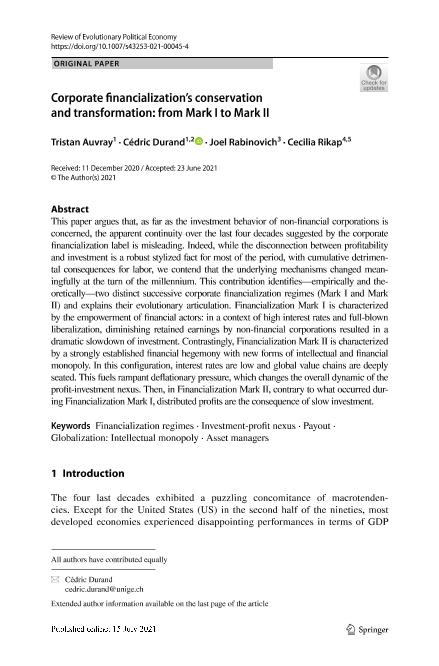Artículo
Corporate financialization’s conservation and transformation: from Mark I to Mark II
Fecha de publicación:
07/2021
Editorial:
Springer
Revista:
Review of Evolutionary Political Economy
ISSN:
2662-6144
e-ISSN:
2662-6136
Idioma:
Inglés
Tipo de recurso:
Artículo publicado
Clasificación temática:
Resumen
This paper argues that, as far as the investment behavior of non-financial corporations is concerned, the apparent continuity over the last four decades suggested by the corporate financialization label is misleading. Indeed, while the disconnection between profitability and investment is a robust stylized fact for most of the period, with cumulative detrimental consequences for labor, we contend that the underlying mechanisms changed meaningfully at the turn of the millennium. This contribution identifies—empirically and theoretically—two distinct successive corporate financialization regimes (Mark I and Mark II) and explains their evolutionary articulation. Financialization Mark I is characterized by the empowerment of financial actors: in a context of high interest rates and full-blown liberalization, diminishing retained earnings by non-financial corporations resulted in a dramatic slowdown of investment. Contrastingly, Financialization Mark II is characterized by a strongly established financial hegemony with new forms of intellectual and financial monopoly. In this configuration, interest rates are low and global value chains are deeply seated. This fuels rampant deflationary pressure, which changes the overall dynamic of the profit-investment nexus. Then, in Financialization Mark II, contrary to what occurred during Financialization Mark I, distributed profits are the consequence of slow investment.
Archivos asociados
Licencia
Identificadores
Colecciones
Articulos(SEDE CENTRAL)
Articulos de SEDE CENTRAL
Articulos de SEDE CENTRAL
Citación
Auvray, Tristan; Durand, Cédric; Rabinovich, Joel; Rikap, Cecilia Alejandra; Corporate financialization’s conservation and transformation: from Mark I to Mark II; Springer; Review of Evolutionary Political Economy; 2021; 2; 7-2021; 431-457
Compartir
Altmétricas




